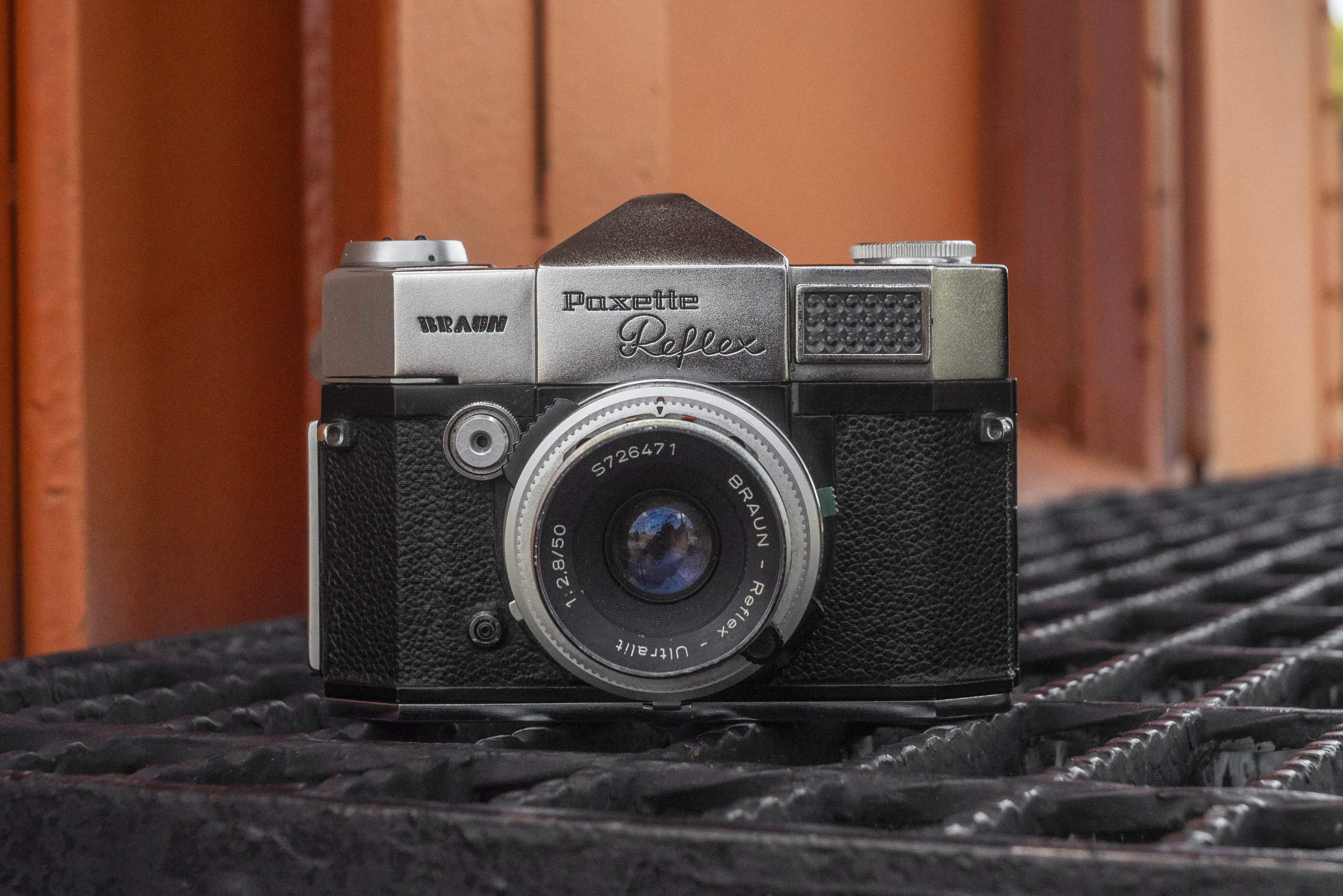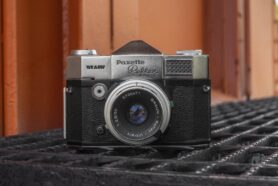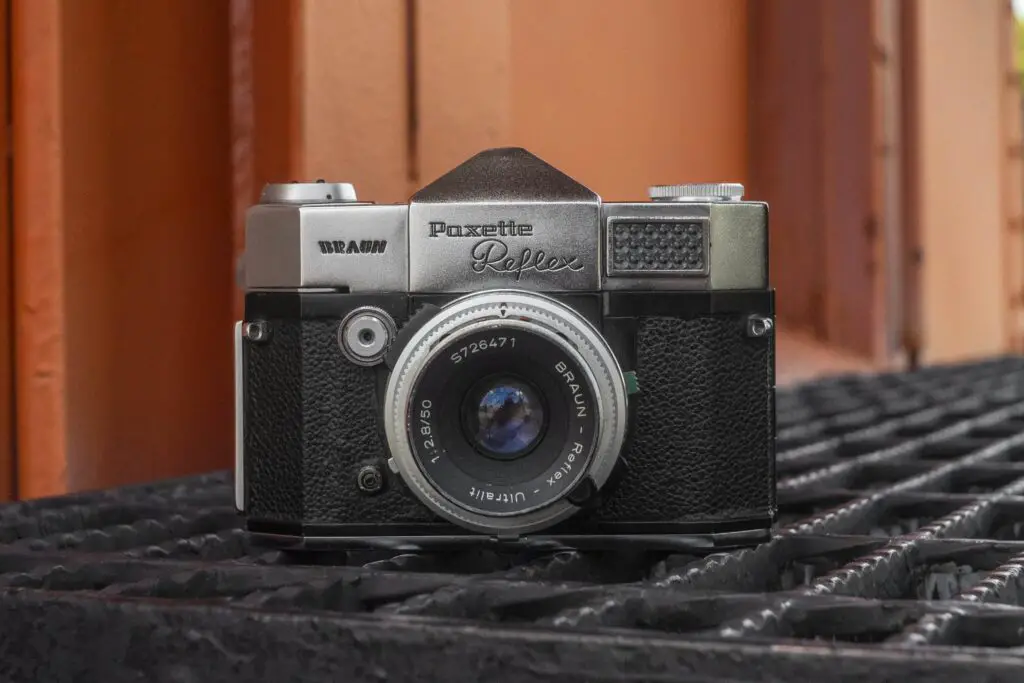This is a Paxette Reflex Automatic, a 35mm single lens reflex camera made by Braun Nurnberg in Nuremberg, West Germany between the years 1958 and 1960. The Braun Paxette Automatic was an SLR version of the long running Braun Paxette series which consisted of a confusing number of scale focus and rangefinder cameras. Paxette Reflex SLRs were made with both fixed and interchangeable lenses. This model has a coupled selenium exposure meter and uses a variant of the Deckel DKL mount, unique to the Braun Paxette, making the lenses incompatible with other DKL mount SLRs. As is the case with all DKL mount SLRs, the Braun Paxette Reflex Automatic uses a Compur leaf shutter which is flash synchronized at all speeds. The Paxette Reflex is a compact, yet basic camera that was produced only for a short period of time, and is hard to find today.
Film Type: 135 (35mm)
Lens: 50mm f/2.8 Enna Braun-Reflex Ultralit coated 3-elements in 3-groups
Lens Mount: Braun Paxette DKL Bayonet
Focus: 1 meter to Infinity
Viewfinder: Fixed SLR Pentaprism
Shutter: Synchro-Compur MXV Leaf
Speeds: B, 1 – 1/500 seconds
Exposure Meter: Coupled Selenium Cell w/ top plate match display
Battery: None
Flash Mount: PC Flash Sync Port with M and X Flash Sync
Other Features: None
Weight: 786 grams, 692 grams (body only)
Manual: https://cameramanuals.org/pdf_files/braun_paxette_reflex_automatic.pdf
How these ratings work |
The Braun Paxette Reflex is an interesting camera made by a company not known for 35mm SLRs. Using the DKL lens mount, the camera should have been compatible with a large number of other DKL lenses made for Kodak, Voigtländer and other German SLRs, unfortunately a change to the bayonet means that only the lenses made specifically for this camera will work. The body is compact and the ergonomics of the camera are good, but a frustrating exposure control system and a dark and extremely cramped viewfinder take away from what would have otherwise been a pleasant shooting experience. This isn’t a bad camera, but when compared to so many other late 1950s 35mm SLRs, there are many more better options. | ||||||
| Images | Handling | Features | Viewfinder | Feel & Beauty | History | Age | |
| 1 | 1 | 1 | 1 | 1 | 1 | 30% | |
| Bonus | None | ||||||
| Final Score | 7.8 | ||||||
My Thoughts
If you were to ask someone to list 10, or even 20 companies that made a 35mm SLR, chances are Braun would not be on that list. For starters, Braun wasn’t a very prolific camera maker, producing a small number of simple to midrange models in the 1950s and early 1960s, but when it comes to SLRs, the list of Braun models is just one, the Braun Paxette Reflex.
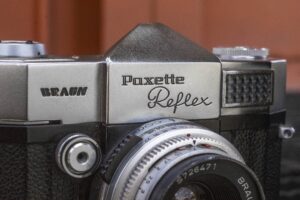
This was a camera that I spotted several years ago when I got my first Paxette rangefinder and quickly forgot about until last summer when I saw one for sale at a very reasonable price. When the camera arrived, I remarked at how compact it was. That this camera was marketed as a Paxette SLR makes sense since the camera very much feels like a Paxette rangefinder or scale focus camera, just with a prism and a taller plate. Side by side with a Paxette rangefinder, the SLR is larger, but still quite a bit smaller than other 1950s SLRs like the original Pentax or Petri SLRs.
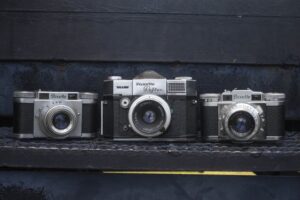
The Paxette Reflex uses the DKL bayonet lens mount similar to the Kodak Retina Reflex and Voigtländer Bessamatic/Ultramatic. Also like those cameras, the Paxette’s DKL mount is slightly different which means lenses between the three systems are not interchangeable, despite the mount being made by the same company. I’ll never understand this logic as having more lenses available for an SLR body makes that body more appealing, not less.
In any case, the Braun Paxette Reflex is an attractive and compact SLR with a feature set that was at least on par with other late 1950s German and Japanese SLRs. The camera is made entirely of brass with little cost or weight saving materials. With the Braun-Reflex-Ultralit 50mm f/2.8 lens mounted, the camera weighs a not insignificant 786 grams, which considering its small size, makes for a very dense feeling camera. The chrome plating used is shiny and deep, still showing most of its original luster without the corrosion or wear of lesser cameras. The synthetic body covering on this example was entirely intact without any peeling or cracks, suggesting it is of an above average quality as well.
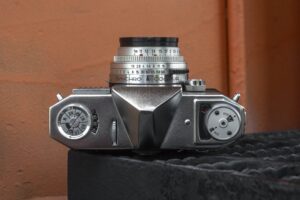
The top plate is similar to other DKL mount SLRs in that there is no shutter speed dial, and that the film advance lever is on the back of the camera. On the left is the combined pop up rewind knob and film type reminder. Film types use abbreviations like UT, UK, NT, NK, and N in which U=Umkehr (Reversal or Slide), N=Negativ, T=Tageslicht (Daylight), and K=Kunstlicht (Artificial Light).
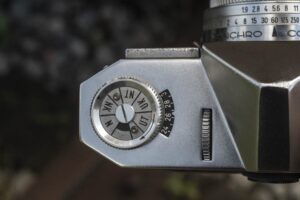
Next to the rewind knob is a window for the subtractive exposure counter showing the numbers of exposures remaining on the current roll of film. The exposure counter must be manually reset by lifting up the rewind knob all the way and shoving your finger underneath and turning a thin and sharply knurled ring near the shaft of the rewind knob. Since the exposure counter doesn’t automatically reset, you must do this after loading in each new roll which is quite inconvenient, and is one of the worst designs of an exposure counter reset I’ve ever encountered.
To the right of the exposure counter is a chrome exposure control wheel. This wheel changes the f/stop setting on the DKL lens. Other DKL mount SLRs made by Kodak and Voigtländer have a similar control, but usually in a different location. The Retina Reflex’s exposure control wheel is on the base of the lens mount and the Bessamatic has it beneath the rewind knob. When using these cameras, it is important to know how these controls work as you cannot change f/stops on the lens directly. Although I’ve never seen the inside of the Braun Paxette Reflex, I can assume that this wheel works like other DKL mount cameras in that there is a string connecting it to the lens mount. Moving the wheel on this particular example is very difficult to do as the lubricants have dried up. This design for the exposure control on these cameras had not aged well and is a common failure point on many other similar cameras.
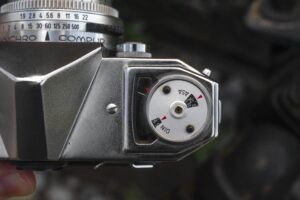
In the center is the pentaprism hump, which on this camera is rather shallow due to the relatively tall height of the top plate. There is no accessory shoe on the camera, although when new, there was probably one that could be clipped to the rear eyepiece. Finally on the far right is the the display for the coupled meter and a dial for setting the ASA or DIN film speed. You can choose from a range of speeds from ASA 10/DIN 11 to ASA 3200/DIN 36. Like most meters of its type, proper exposure is obtained when a white needle controlled by the selenmim meter matches a red arrow controlled by the exposure control wheel. If no movement of the exposure control wheel allows the two arrows to line up, then you must either switch to a different shutter speed, or move the camera to an area with better lighting.
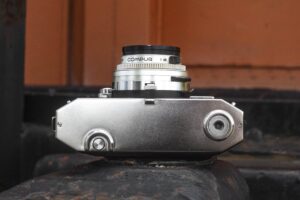
Flip the camera over and you’ll find a 1/4″ tripod socket on the side of the camera which is not ideal as it doesn’t allow the camera to sit balanced on a tripod, and on the opposite side the rewind release button. A very small bump in the center, just behind the lens mount acts as a foot to stabilize the camera as it sits on a flat surface.
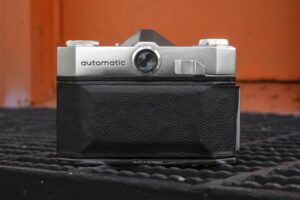
Around back, the camera has the word “automatic” engraved into the plate to the left of the eyepiece. This is a strange location for the branding of the camera, and something that I would expect to be up front or at least on top. The round eyepiece is threaded and can be unscrewed which supports my theory of some kind of detachable accessory shoe or perhaps even some other kind of viewfinder accessory. To the right is the film advance lever which is conveniently located in easy reach of your right thumb. The total movement of this lever is about 180 degrees and can be done in one single motion.
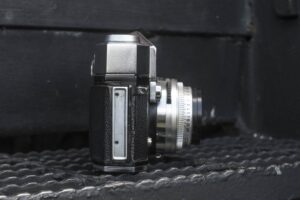
The sides of the camera are mostly symmetrical with a film door release latch on the right side and forward angled metal strap lugs on both sides. The inclusion of strap lugs is convenient considering the weight of this camera. Although I only had the 50mm f/2.8 lens, with one of the two longer telephoto lenses, the forward angle of the lugs would have helped prevent the camera from falling forward.
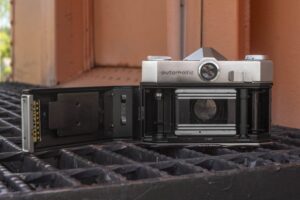
Opening the left hinged film door reveals the Paxette Reflex’s film compartment. Film transports from left to right onto a fixed plastic take up spool. A characteristic of the somewhat narrow width of this and other Paxette cameras is that the chambers for the film cassette and take up spool are angled inwards slightly. This results in both spools being farther forward than on most cameras making film loading slightly more difficult. Threading the film leader into the slot in the take up spool will likely take some getting used to for first time users of this camera, but is otherwise uneventful. In the middle of the film gate is a capping plate which is something that is necessary on all leaf shutter SLRs. Unlike focal plane shutters in which the shutter curtain is immediately in front of the film gate, on a leaf shutter SLR, the shutter blades are in front of the reflex mirror, and must be open to allow light to pass through into the viewfinder. Since the shutter is open while looking through the viewfinder, the capping plate drops down behind the mirror, blocking light from entering the film compartment and exposing the film.
Above and below the film gate are three rows of unpainted metal rails and on the inside of the door is a large and smooth film pressure plate. There is no light seal on the door hinge, but there are cloth seals in both the upper and lower door channels. Like most cloth seals, the ones here were still in good shape and did not require replacement.
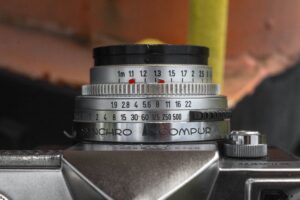
Looking down at the 50mm f/2.8 Enna Braun-Reflex Ultralit lens, the controls should be familiar to anyone whose used a DKL mount SLR before. Controls for shutter speed and aperture are on the shutter itself and are not part of the lens. This explains why you see a setting for f/1.9 despite this being a lens with an f/2.8 maximum aperture. Both the shutter speed and aperture rings are coupled together and turning one also turns the other, maintaining a consistent EV number. The lens mount allows direct control of only shutter speeds. You must use the exposure control wheel on the top plate of the camera to change f/stops.
The only control on the lens itself is focus, which has an engraved scale in meters only from 1 meter to infinity. The Ultralit lens has front group focus and lacks a focusing helix. In addition two red pins that independently move as you change f/stops show depth of field. This design was found on many DKL and some other mount German lenses. It is a clever design, but also added complexity to the construction of the lens, and also likely contributes to these lenses feeling stiff over the years as the moving parts slow down with age.
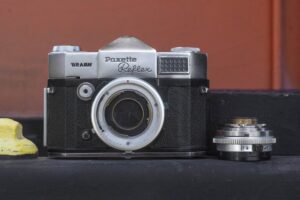
Up front, is the lens mounted to the DKL lens mount. Removing the lens requires you to push in a metal pin beneath the shutter and rotating the lens counterclockwise. Installing the lens is a matter of aligning a red dot on the lens to a red dot at the very top of the mount and rotating clockwise until the lens clicks into position. A total of five lenses were made for the Braun Paxette Automatic. The 50mm f/2.8 Ultralit seen here, but also a 50mm f/1.9 Steinheil Reflex-Quinon, a wide angle 35mm f/3.5 Enna-Werk Reflex-Lithagon, and two telephotos, a 135mm f/4 Rodenstock Reflex-Rolear, and a 200mm f/4.5 Enna-Werk Reflex-Tele-Ennalyt. Overall the removal and attachment of a lens is uneventful, as it should be.
Above and to the left of the lens is a rather large round shutter release. The shutter release is threaded for a cable release and is conveniently located in each reach of the photographer’s right index finger. I have generally liked cameras with front shutter releases like this as the action of squeezing the shutter release stabilizes the camera into your face, helping to reduce body shake while using slower shutter speeds. Below and to the left of the lens is the flash sync port which supports both M and X flash synchronization which is selected by a green lever near the 3 o’clock position on the side of the shutter. The flash sync lever also has a third position, marked V, which is for activating the self timer.

The viewfinder is reasonably bright for a low production 1950s SLR, but still darker than most film shooters would be used to. In the center is a large and very easy to use split image focusing aide. The outer edge of the focus aide has a dark circle which is reminiscent of the split image viewfinders on an Ihagee Exakta. I am not exactly sure why these early SLRs had focus aides that look like this, but it is worth noting. The entire viewfinder can be focused unlike some other early leaf shutter SLRs, but it is definitely easier to use the split image. The biggest con to the Braun Paxette Reflex’s viewfinder is its size. While wearing prescription glasses, it is impossible to see all four edges of the focus screen. Only if I remove my glasses and press my eye uncomfortably close to the camera can I see the entire image at once. There is no other information like exposure information or a meter readout, visible in the viewfinder.
The Braun Paxette Reflex Automatic is a reasonably good camera. It has everything a late 1950s photographer might want in an SLR, however it came out at a time of great change. What might have been acceptable in 1958 would have been quickly out of date in 1959. Furthermore, this being a last ditch attempt at an SLR from a company that was on the verge of irrelevance shows in its design. While handling the camera, I can’t help but get the feeling this was a half-hearted attempt at SLR-ifying the Paxette rangefinder, and with the use of the DKL mount, but with a Braun specific bayonet, means that lens options were limited.
If all you needed was a German SLR with decent lenses, the Braun Paxette Reflex Automatic would have fit the bill, but with the benefit of hindsight, this would quickly become a relic of the past. But for that brief moment of relevance it might have had, what would it have been like to shoot? Keep reading…
My Results
When this Braun Paxette Reflex came to me, it was in good cosmetic but rough functional shape. Initially, the shutter didn’t fire at all, but after working it over and using some naphtha oil on the blades, it began to loosen up. The aperture control wheel was very stuff as was the focus ring, and pressing the shutter release required more effort than I thought was normal, but it was working, so I threw in some expired Kodak Gold 200 and took it out. I figured that if I got anything from it, that would be better than nothing.
In what should probably surprise no one, a camera in a questionable operational condition put into use without proper service could not survive a single roll of film. Although I did see that the shutter was firing before I ever loaded film, by the time I got through the first couple exposures, I could feel the camera struggling. There was a noticeable delay from when I would press the shutter release and I’d hear the actual shutter firing. The exposure controls remained stuff, and I noticed that no matter how I focused the camera, the image in the viewfinder never seemed particularly sharp, so I gave up on focusing with the viewfinder and instead just used it to compose my image and then I zone focused it using the numbers on the lens. By the 12th or 13th exposure, the camera completely locked up, and unable to keep advancing the film, I gave up and transferred the film to another camera and set the camera aside.
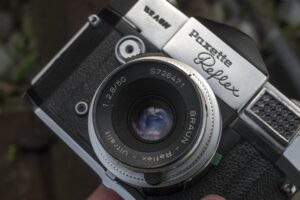
Of the images I did get, I can see that the Braun Paxette Reflex Automatic was a capable, but not spectacular camera. Images shot with the 50mm f/2.8 Enna Braun-Reflex Ultralit triplet show even sharpness across the frame with a tad bit of vignetting in the corners, but no significant optical aberrations such as those seen on lesser lenses. Many of the images show overexposure as the shutter almost certainly was staying open too long while using the camera, but strangely the indoor scenes look the best. I missed focus on the mirror selfie, but that was because it was the first image on the roll before I realized the camera wasn’t focusing correctly.

While shooting the camera, I quite liked its ergonomics. The body is tall but narrow and is easy to grip while casually walking around. The size and location of the front shutter release is very comfortably located, in easy reach of my right index finger. The action of pressing the shutter release is similar to that of other front shutter release cameras like a Topcon RE Super and most Miranda SLRs.
I did not use the meter while shooting as I was preoccupied with whether the shutter would keep working, but while testing it, the meter still responded to light and seemed correct when compared to what I would have picked while using Sunny 16.
Overall, there’s not a lot to love about my time with this camera, but that’s okay. I feel as though with the experience I have shooting other cameras of similar age and style, when found in proper working condition, the Braun Paxette Reflex Automatic is a fine camera. I could never find any period advertisements or catalog prices suggesting what it might have sold for, but it was almost certainly an economically priced model, so anyone buying it probably would have been satisfied with its use and the image it made.
The Braun Paxette Reflex Automatic was a last ditch effort at an SLR, and it shows. Depending on what you are looking for in a vintage camera, that may not matter to you. If you like uncommon cameras that don’t exactly look like anything else out there, you may want to add one of these to your collection. If it works, it might even be a fun camera to shoot. The reality is though, leaf shutter SLRs often struggle to stay operational after half a century without repairs, so the chances of finding one in good shape is pretty slim. I am glad I have this camera and got to shoot a couple images with it, but it is not something I would ever invest any money (or film) in it again.
Related Posts You Might Enjoy
External Links
http://camera-wiki.org/wiki/Braun_Paxette_Reflex
https://forum.mflenses.com/braun-paxette-reflex-lenses-t81092.html

